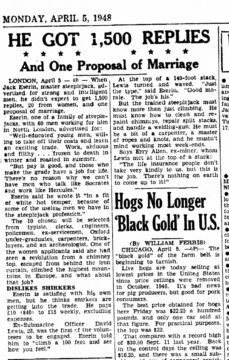Thrillseekers! Are you girding your loins to rejoin the amusement park crowds this summer?
No worries if you don’t feel quite ready to brave the socially distanced rollercoaster lines. Indulge in some low-risk vertigo, thanks to British Pathé‘s vintage newsreels of steeplejacks, steelworkers, and window cleaners doing their thing.
While these tradespeople were called in whenever an industrial chimney required repair or a steel beam was in need of welding, many of the newsreels feature iconic locations, such as New York City’s Woolworth Building, above, getting a good stonework cleaning in 1931.
In 1929, some “workmen acrobats” were engaged to adorn St. Peter’s Basilica and the Vatican with thousands of lamps when Pope Pius XI, in his first official act as pope, revived the public tradition of Urbi et Orbi, a papal address and apostolic blessing for the first time in fifty-two years.
Some gender boundaries got smashed in the aftermath of WWII, but “steeplejills” were novelty enough in 1948 that the scriptwriter predictably milks it by having the announcer crack wise to and about the unidentified woman ready to climb all the way to the rim of a very tall smokestack.
“There it is! That long thing pointing up there, it’s all yours!”
These days such a jib might constitute workplace harassment.
Did she get the job?
We don’t know. We hope so, whoever she is — presumably one of twenty female Londoners responding to the help wanted ad described in the Lethbridge Herald, below:

Watch more scenes of vintage steeplejacks — and jills — at work in a British Pathé “Nerves of Steel” playlist here.
Related Content:
Watch 85,000 Historic Newsreel Films from British Pathé Free Online (1910-2008)
Ayun Halliday is an author, illustrator, theater maker and Chief Primatologist of the East Village Inky zine. She’s had a terrible fear of heights since a near miss in the Trogir Bell Tower some 14 years ago. Follow her @AyunHalliday.
Nerves of Steel!: Watch People Climb Tall Buildings During the 1920s. is a post from: Open Culture. Follow us on Facebook and Twitter, or get our Daily Email. And don't miss our big collections of Free Online Courses, Free Online Movies, Free eBooks, Free Audio Books, Free Foreign Language Lessons, and MOOCs.
from Open Culture https://ift.tt/3xzvIcv
via Ilumina





Comments
Post a Comment